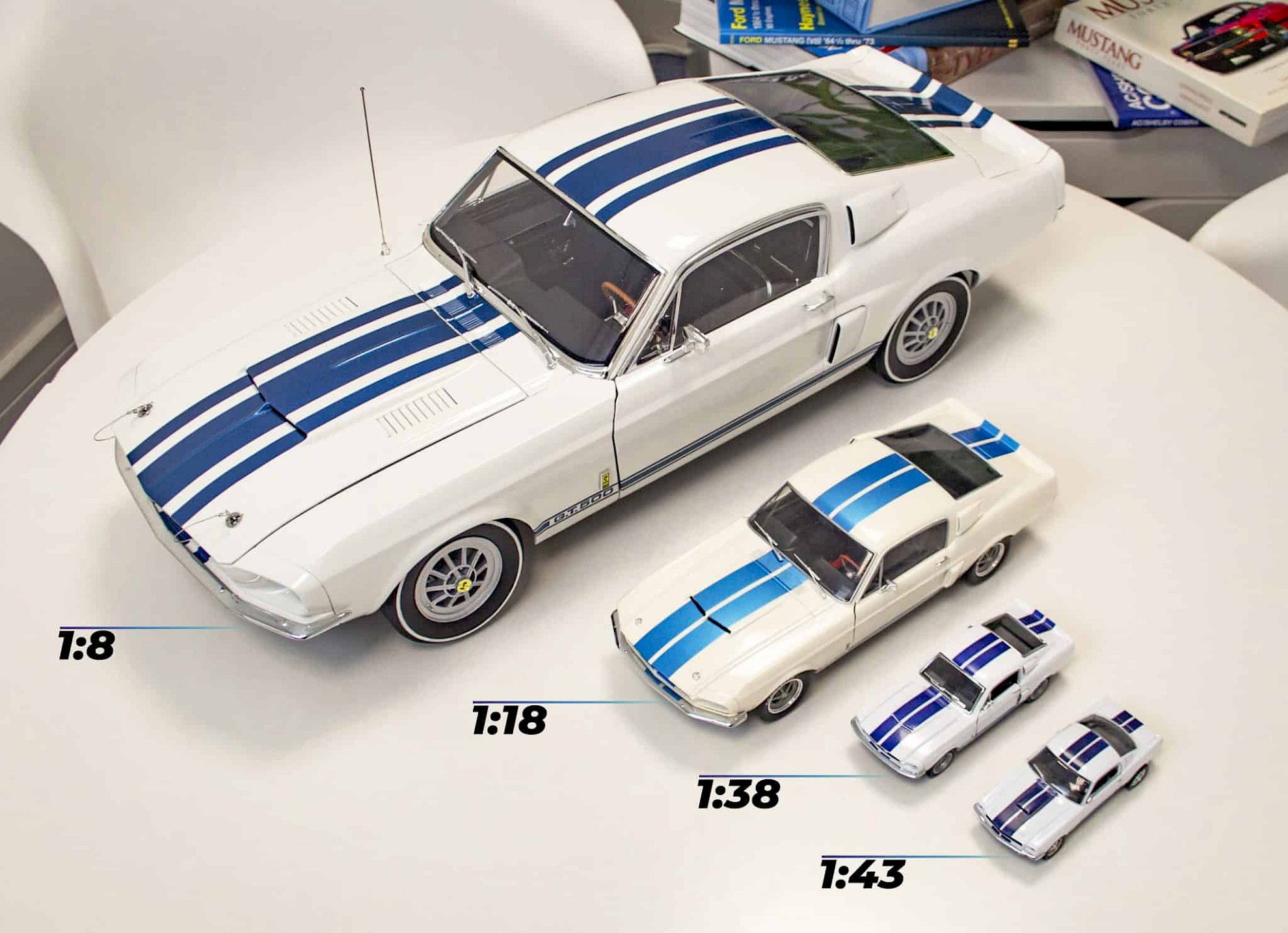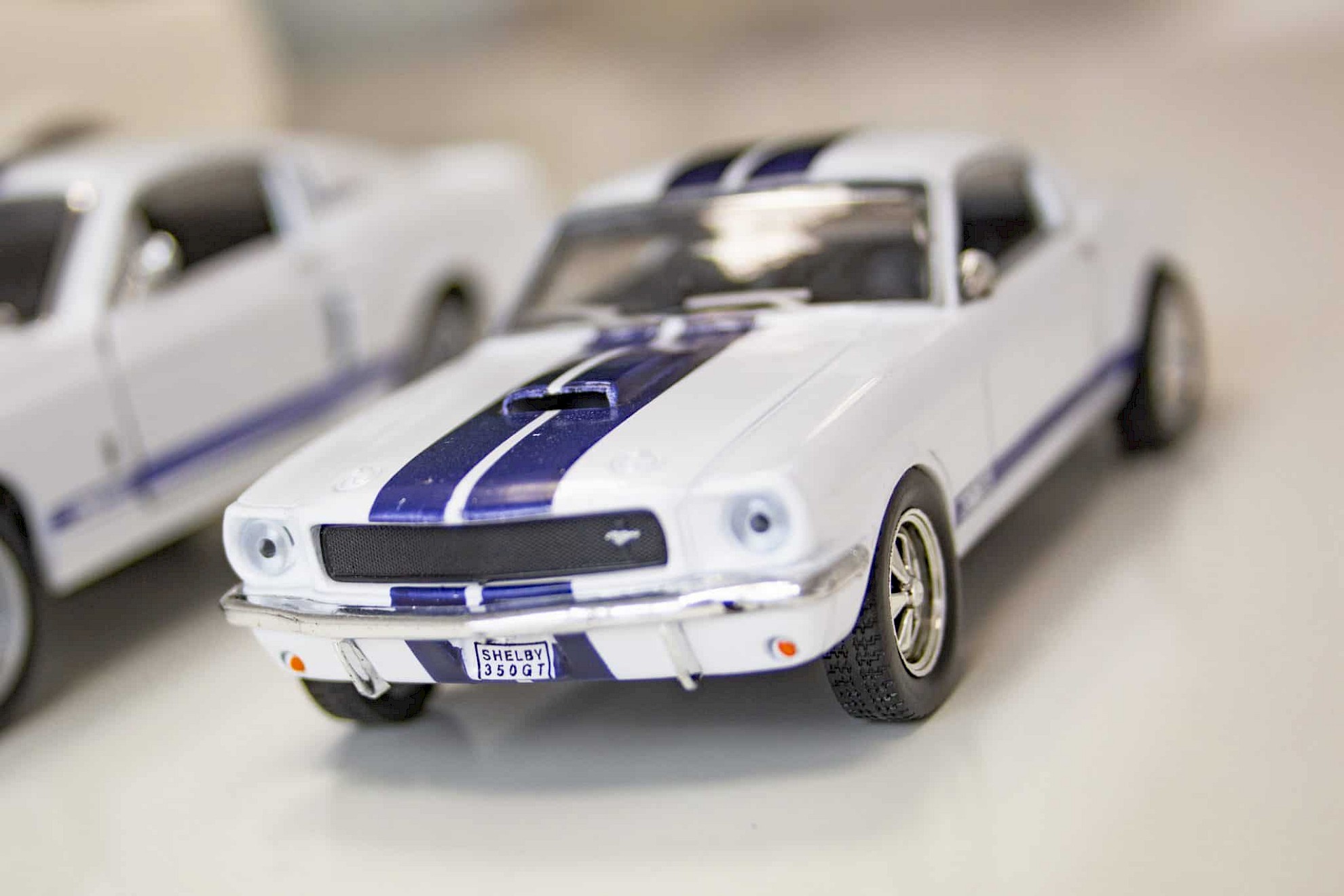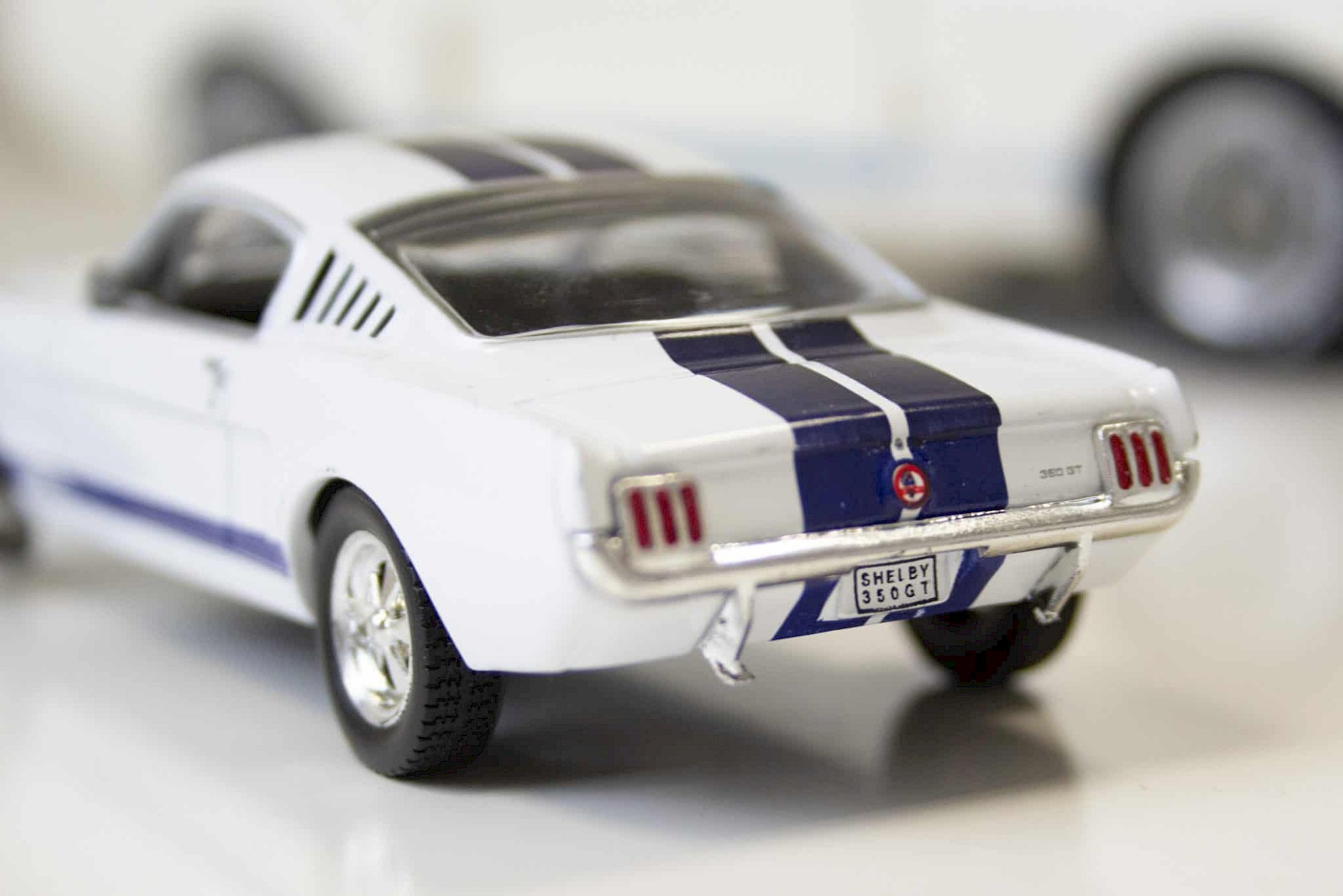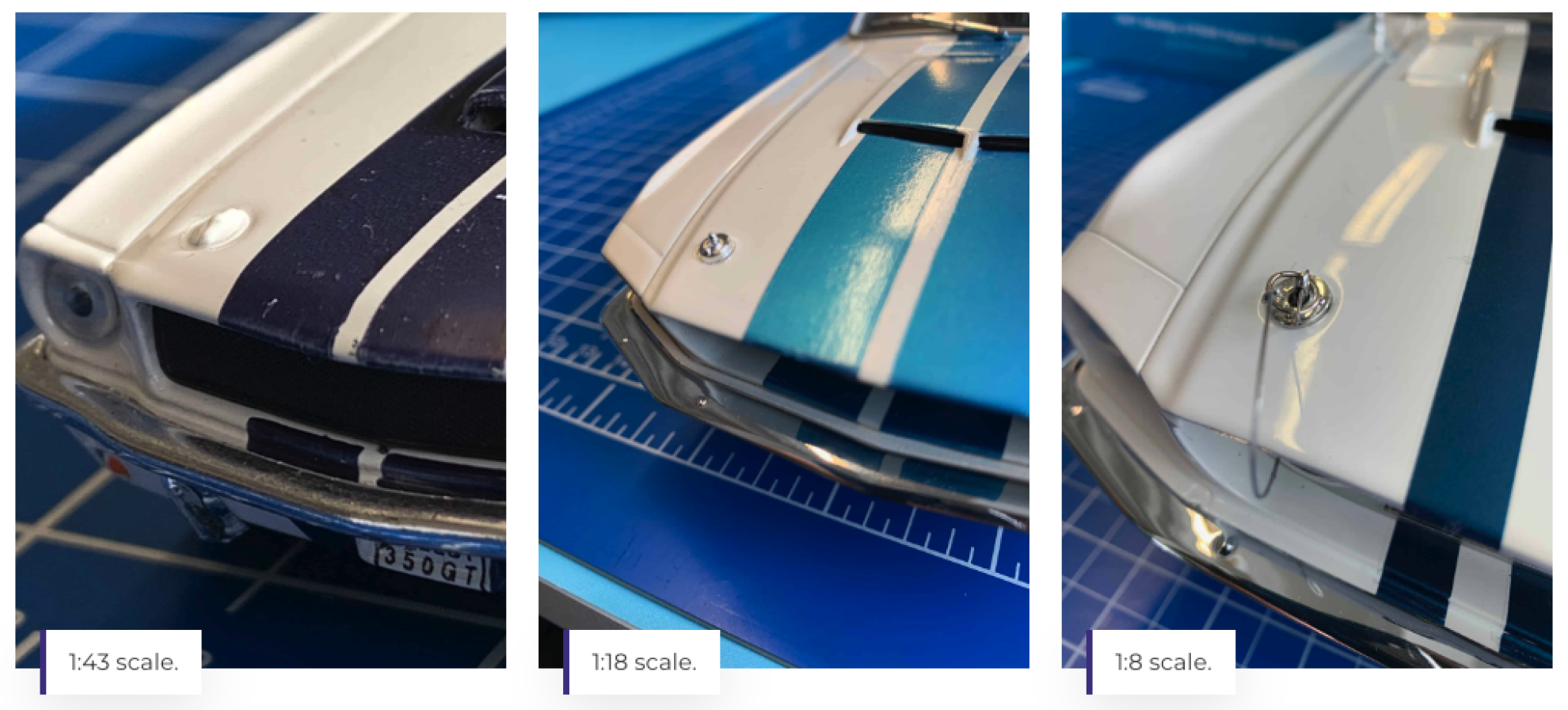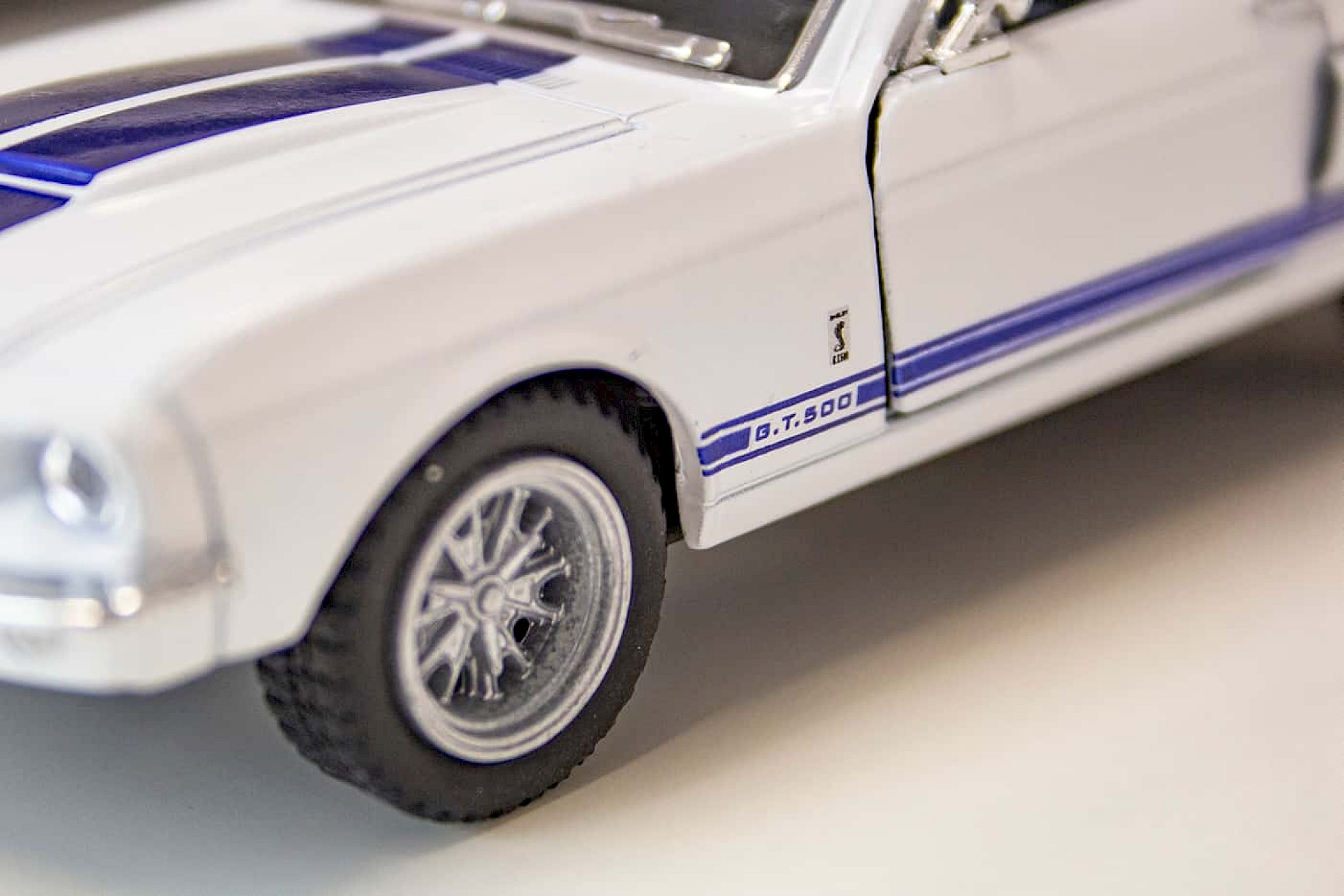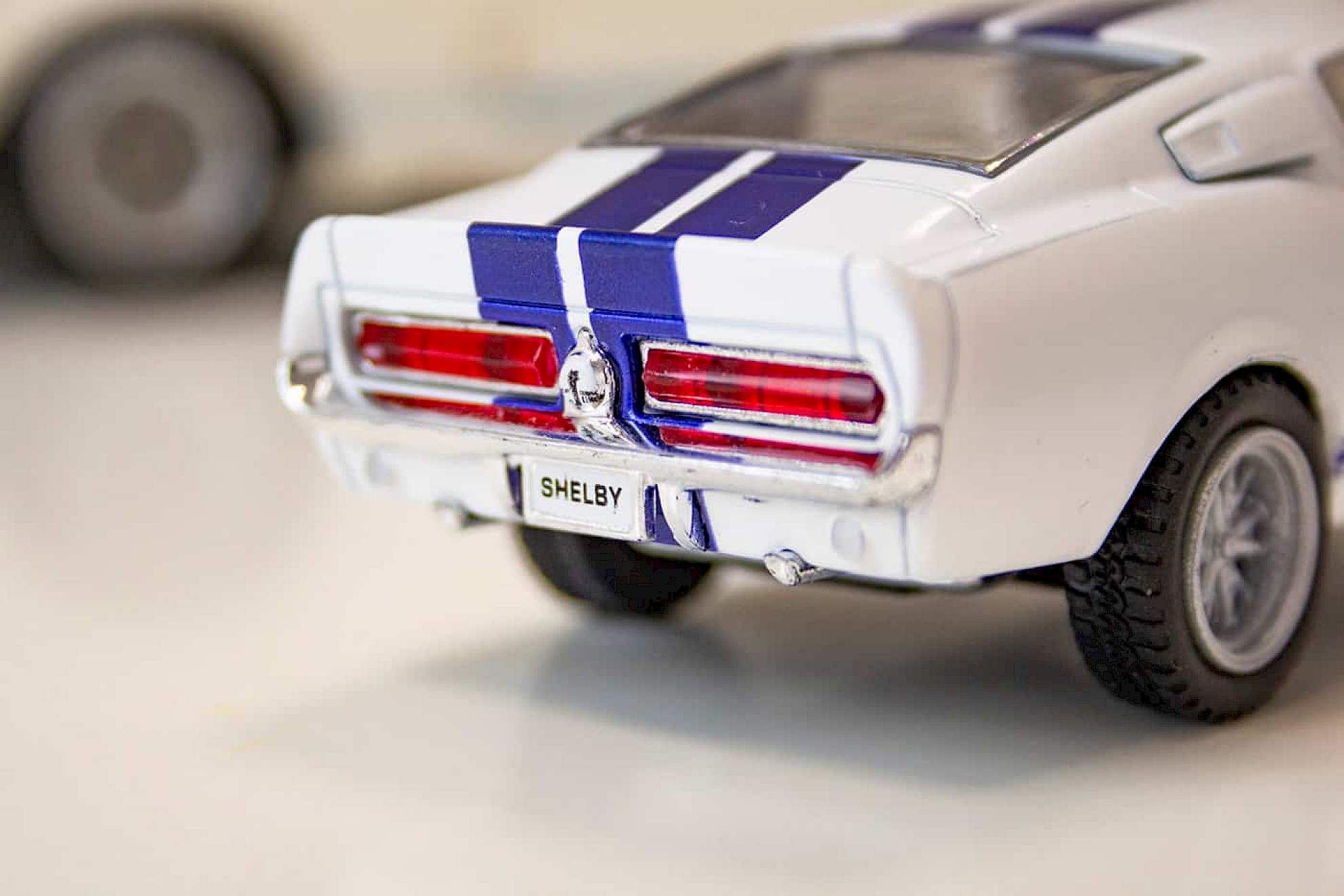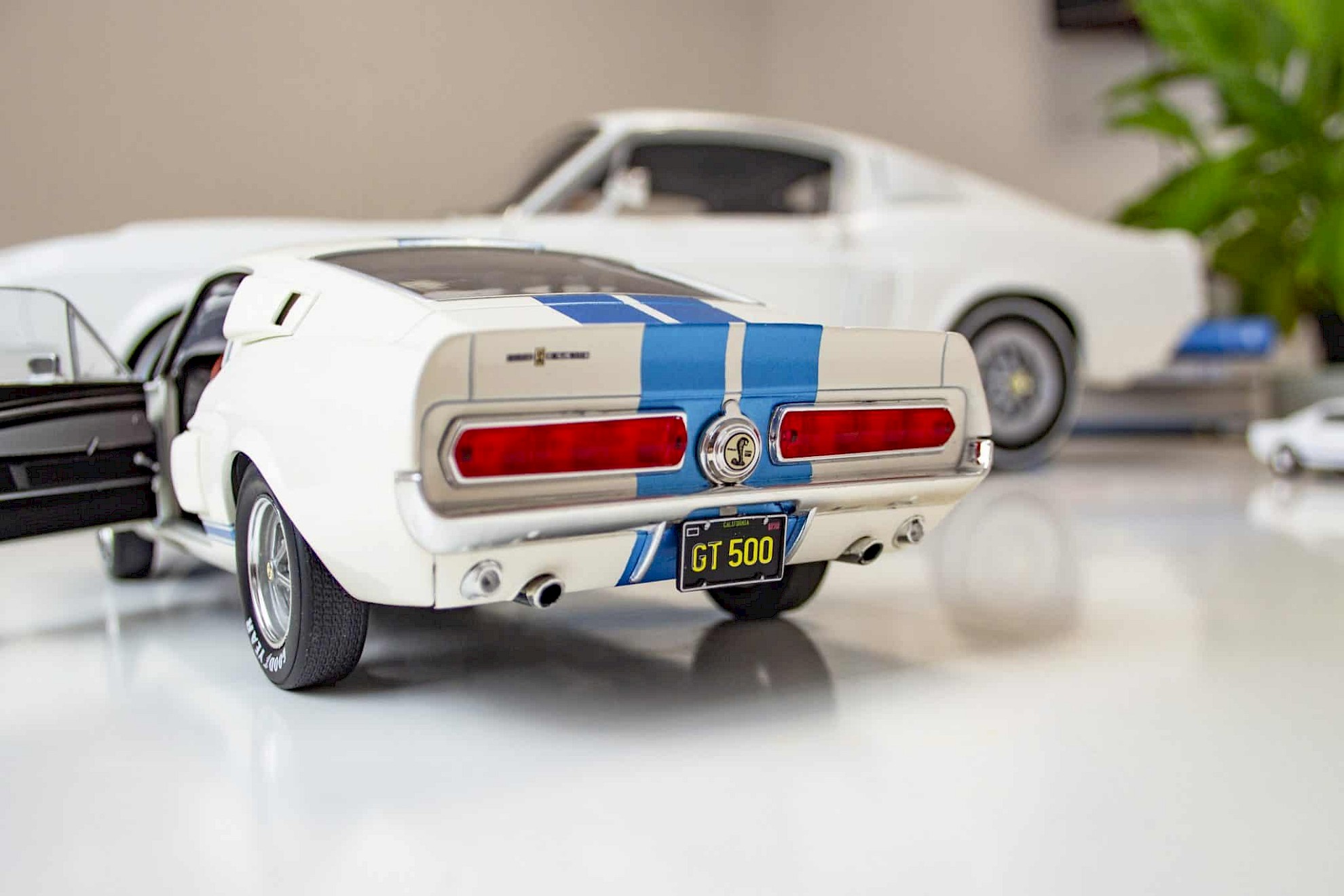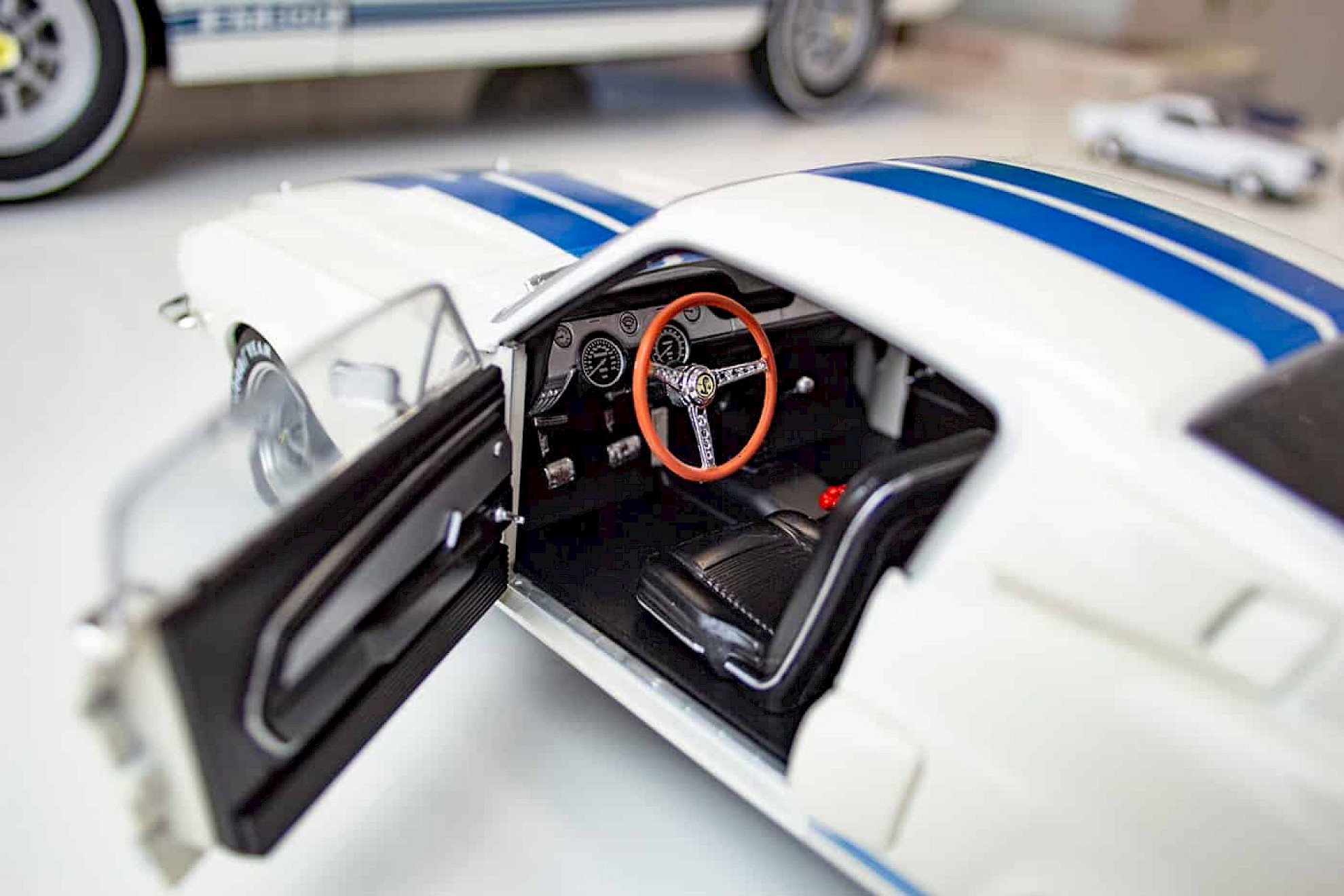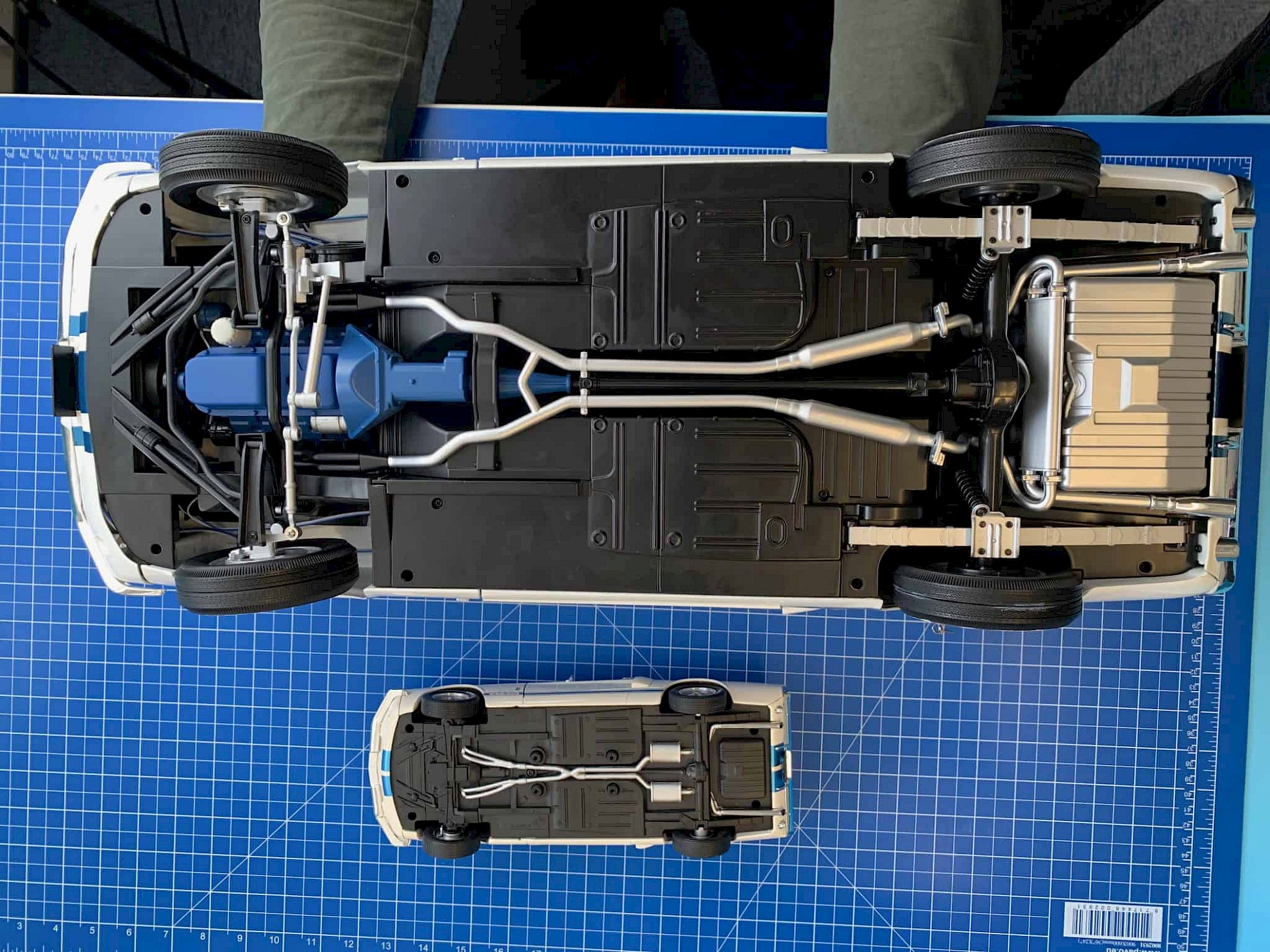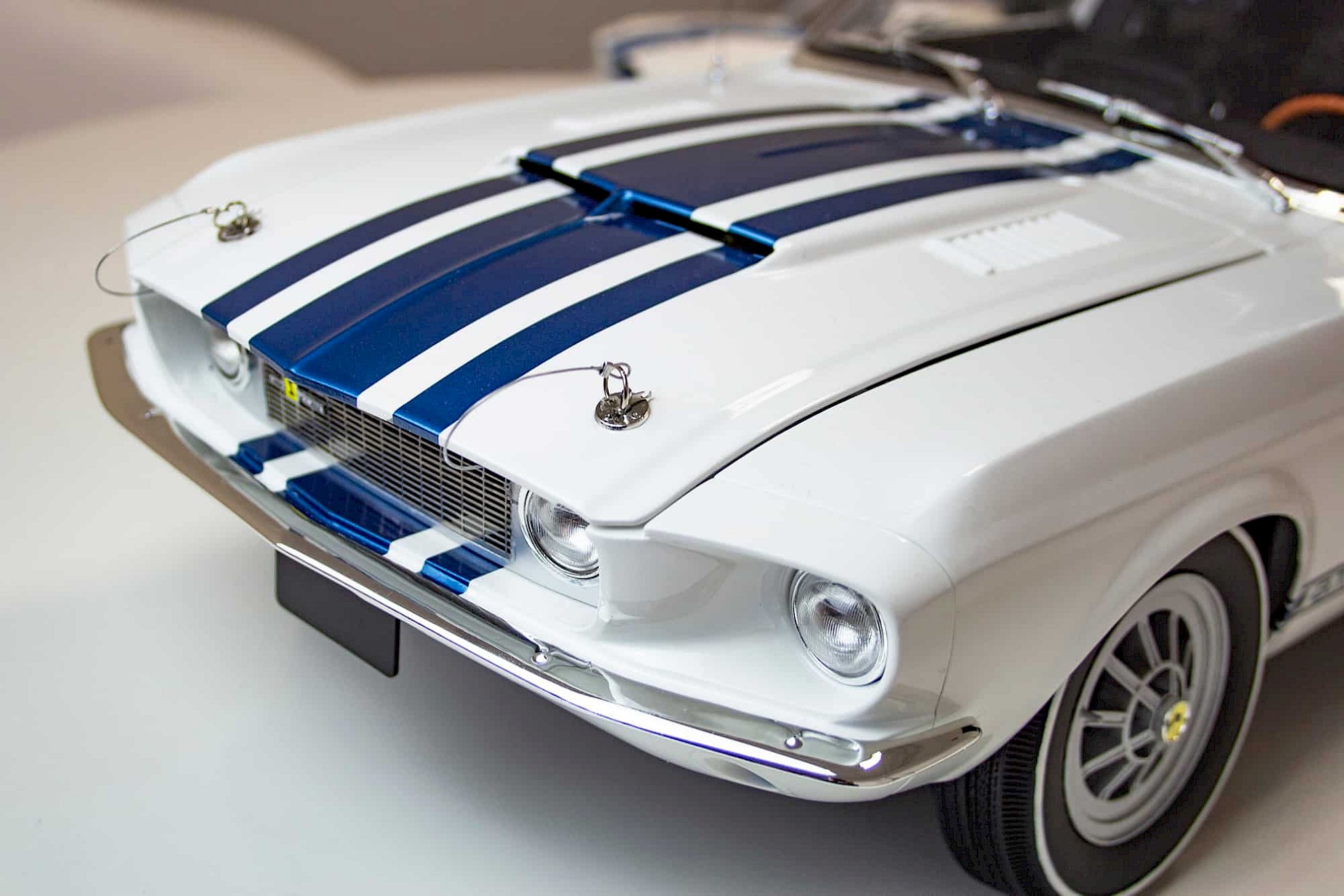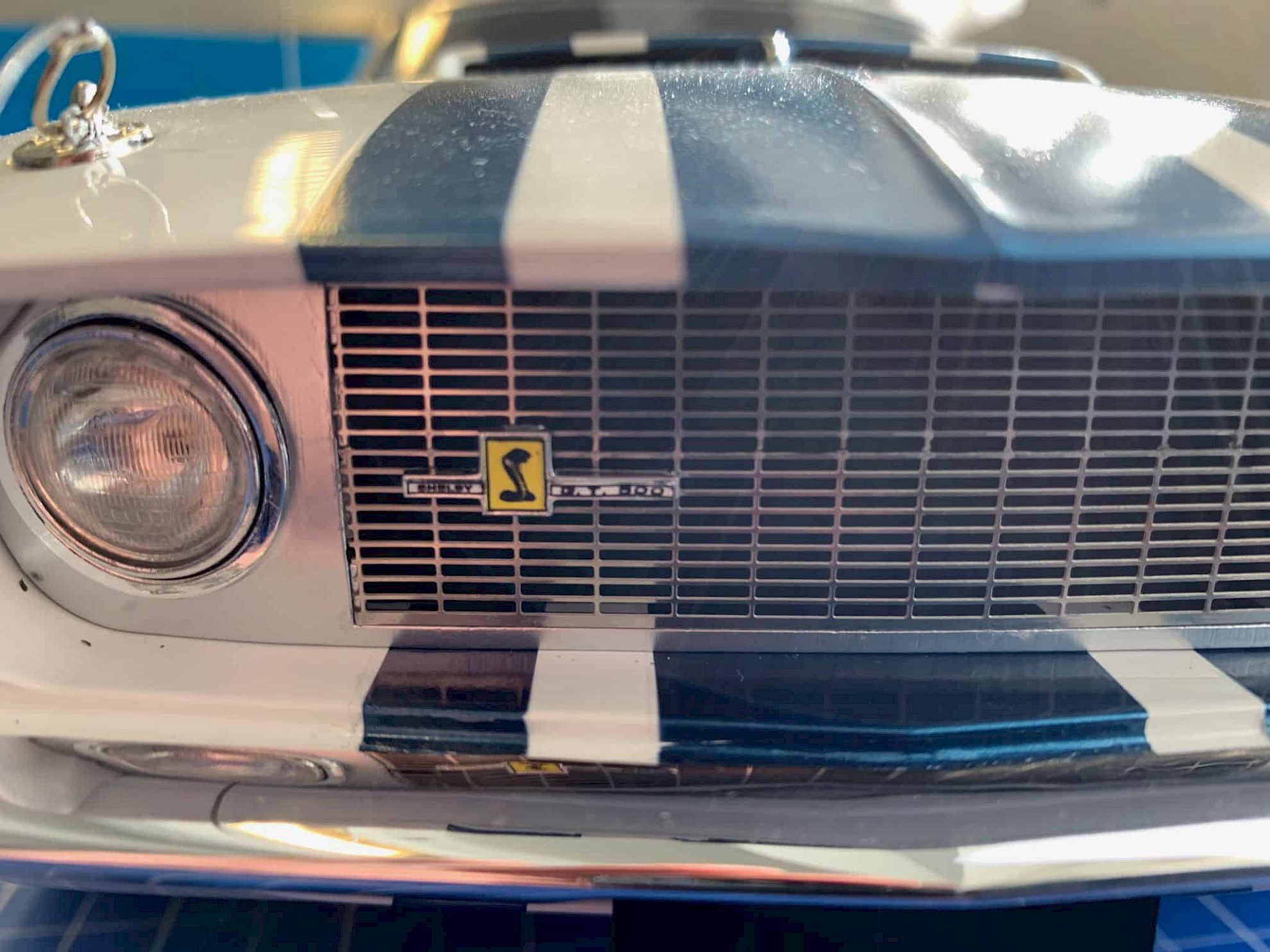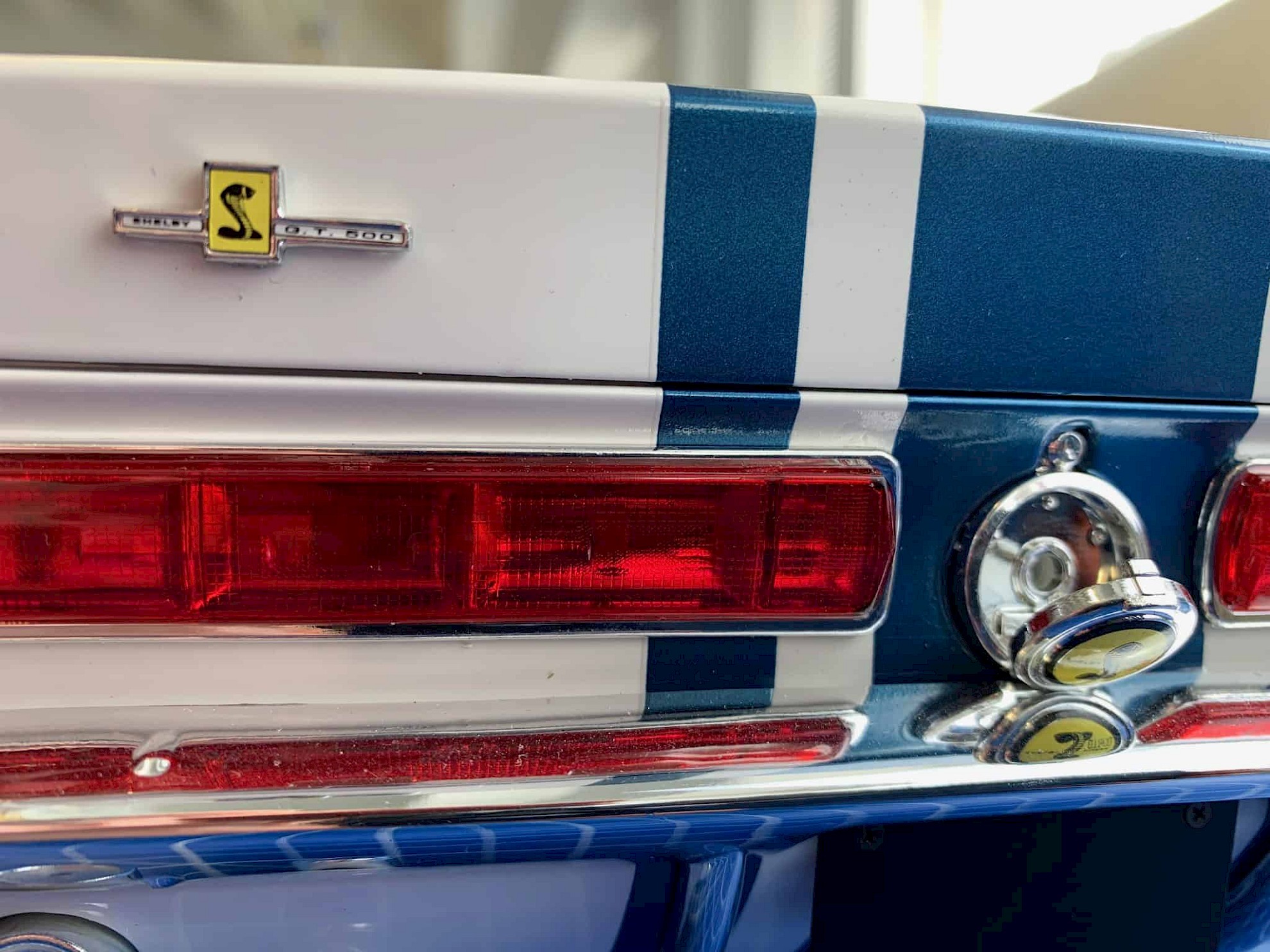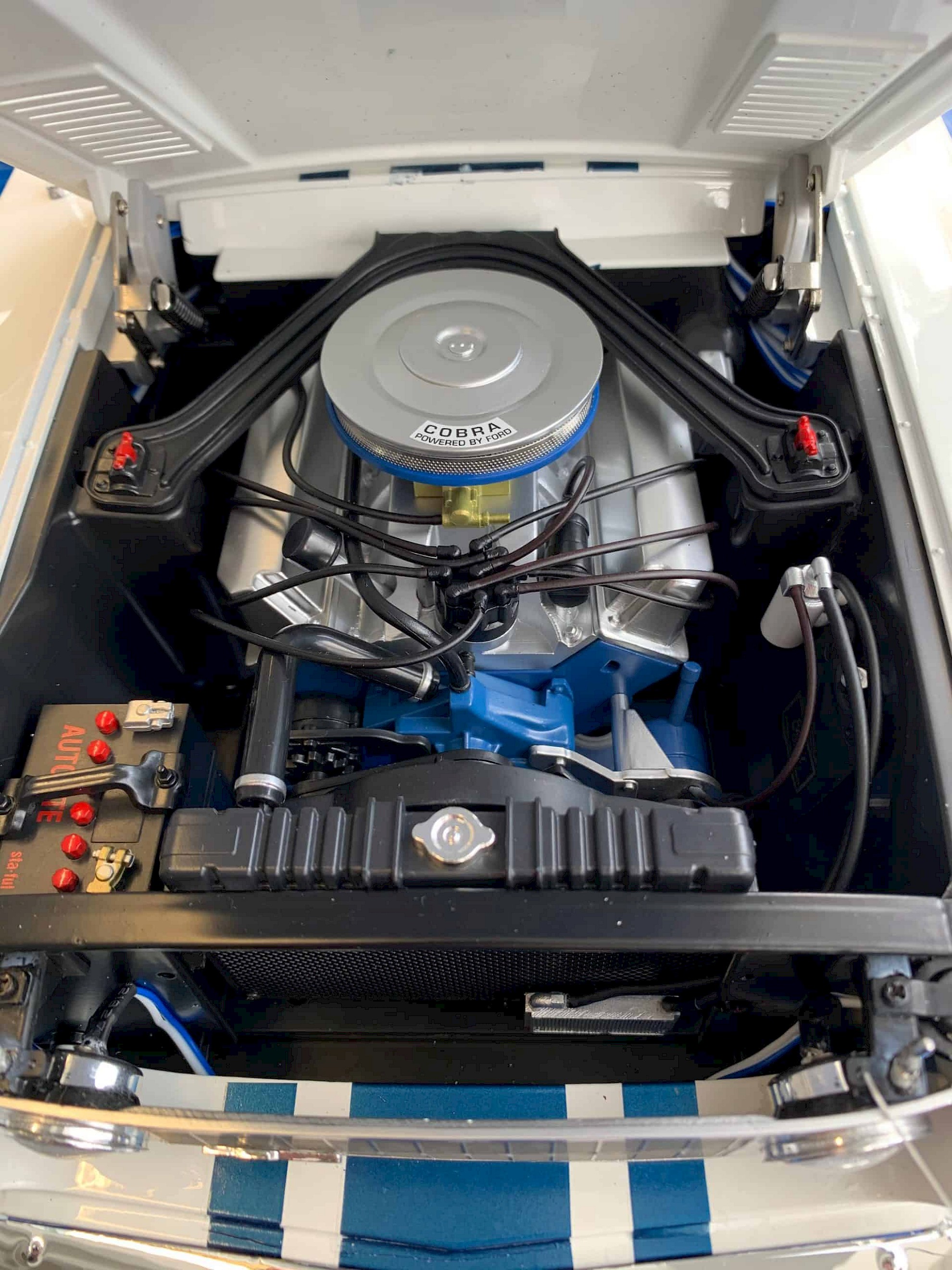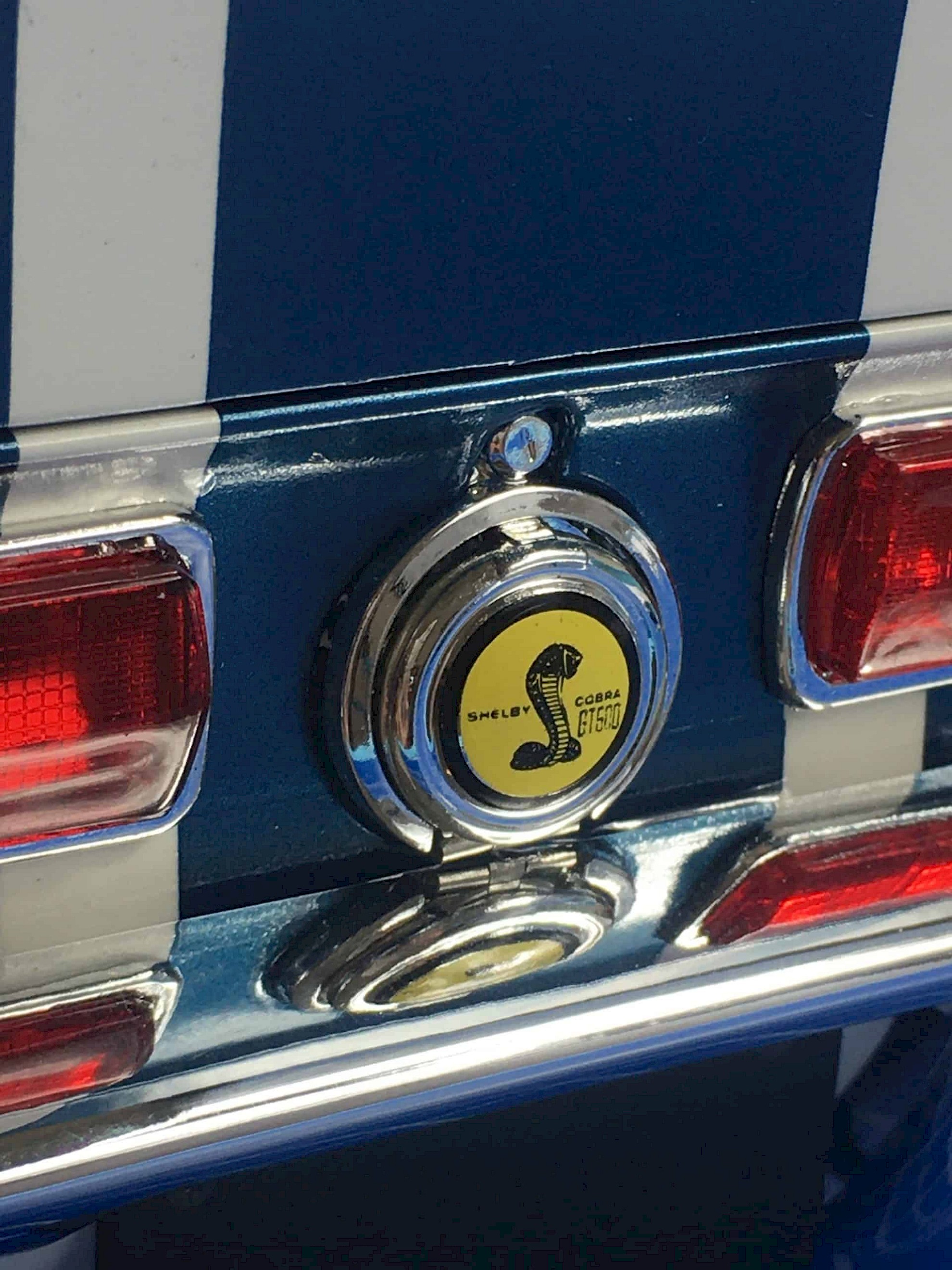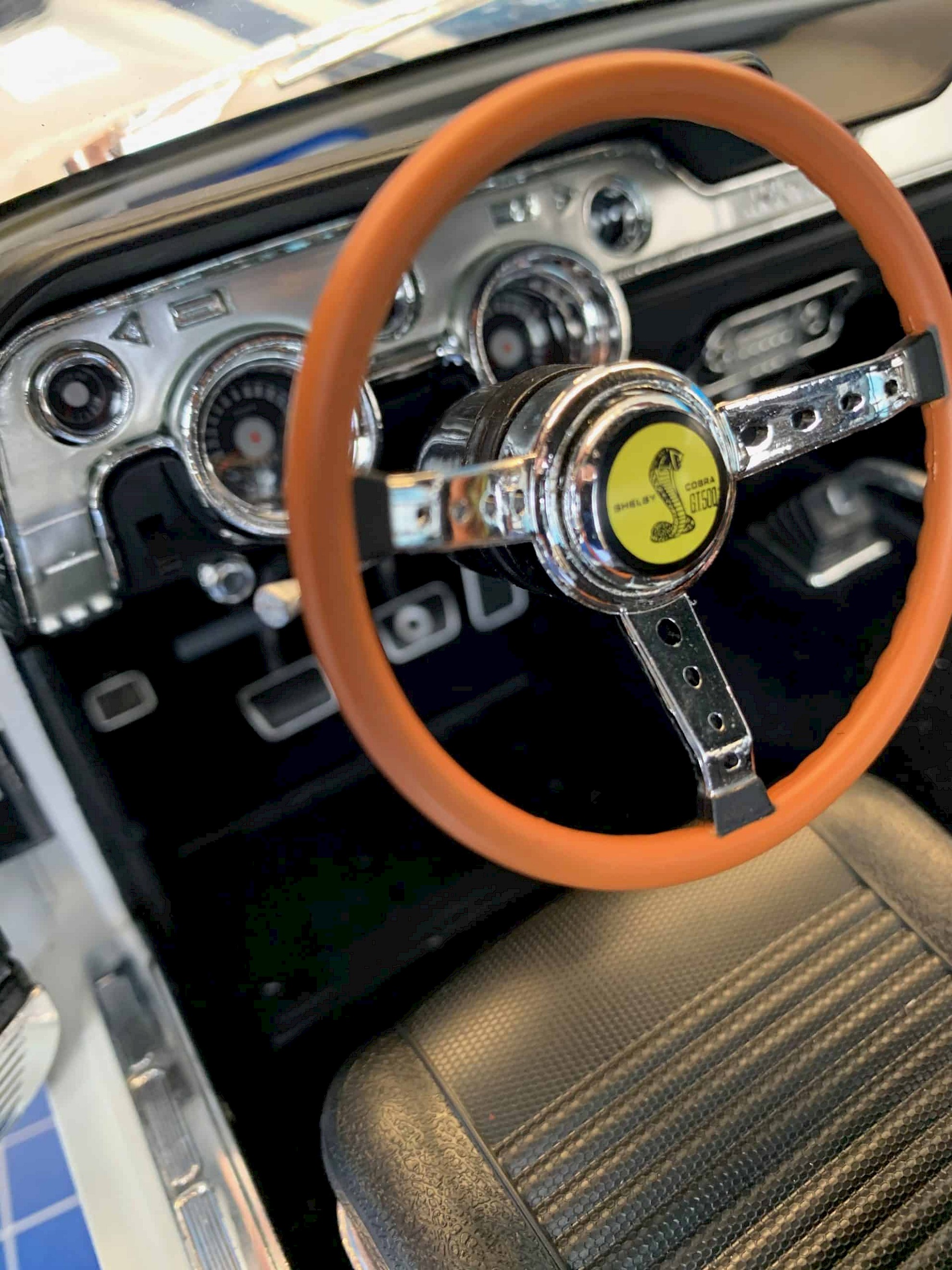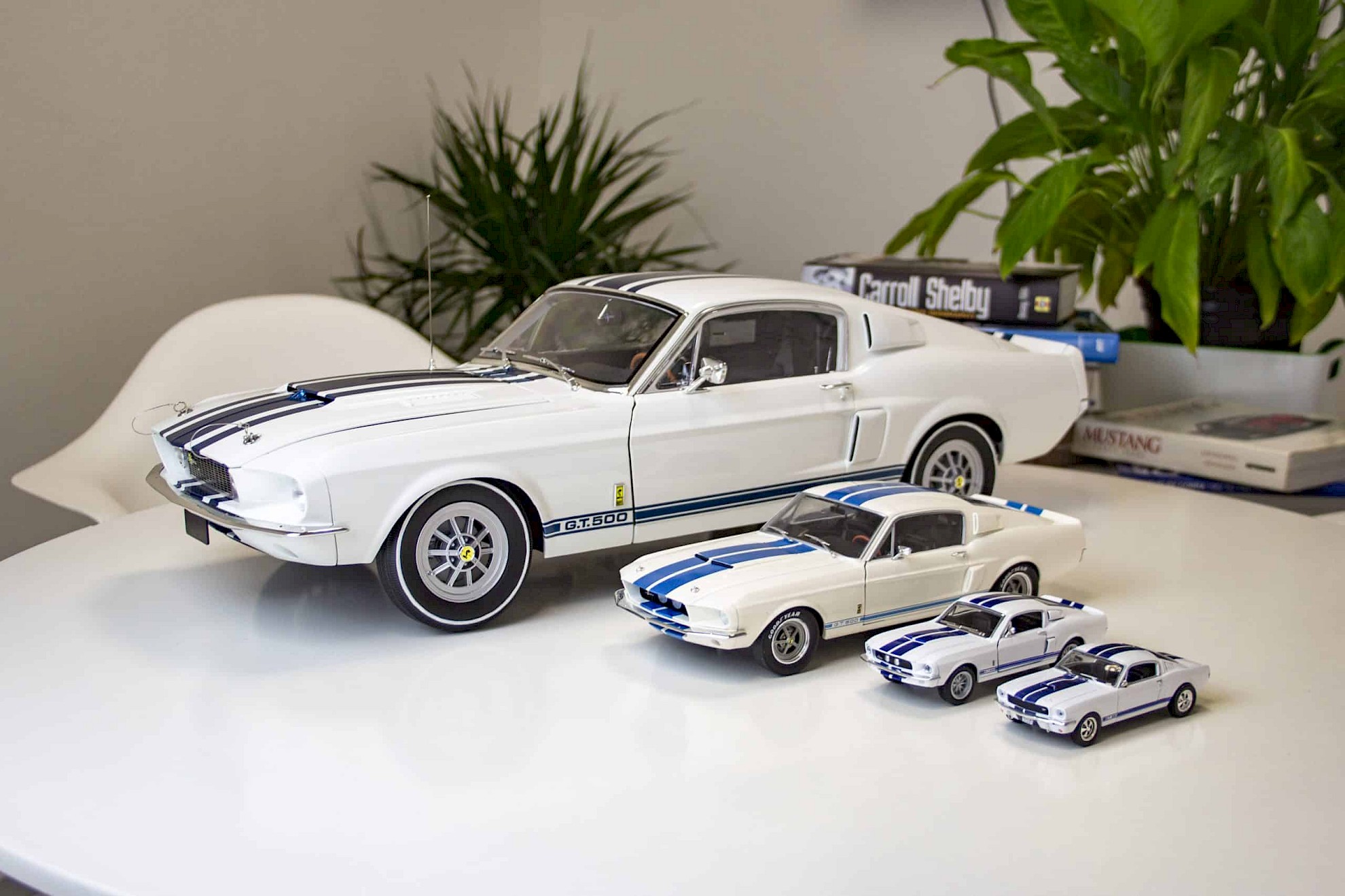Model Scales, What’s the Difference?
Do You Know Your Scales? A Quick Ride from 1:43 to 1:8
Just how much detail can you achieve at 1:8 scale – and why is this Agora Model’s preferred size for their 1967 Shelby Super Snake model car?
To find out exactly what 1:8 offers, we bought three more models at varying sizes – 1:43, 1:38 and 1:18 – to see how they match up to our 1:8 model. To try to keep it fair we choose three other standard scales from the same retailer at prices which are typical for each relevant scale. We also chose white with blue stripes editions of each mustang.
The Super Snake and Shelby Mustangs at four different scales.
(Of course, the Super Snake is one-of-one, and there aren’t that many scale models of it, so we had to settle for scale models of the 1967 Shelby GT500 and GT350 instead).
Here’s what we learnt:
1:43 scale
Shelby GT350 at 1:43 scale.
Ok, so we couldn’t actually find a 1:43 scale model of a 1967 GT500 either! Instead we’ve got a 1965 Shelby GT350 (identified by the louvers instead of quarter windows), one of the precursors to the 1967 GT500 (and, therefore, the Super Snake).
Immediately, the color stands out.
Wimbledon White, the lovely off-color white that has become synonymous with the early Shelby Mustangs (all 1965 models were built in this color, and about 40% in 1966), has been replaced by a much starker shade (which was never standard).
We are so accustomed to the Wimbledon White–Guardsman Blue combination, that this white just doesn’t look right on a Shelby Mustang!
Looking past the color, it is interesting to see just how much detail this model has been able to include.
For example, a nice touch is the tiny writing on the back which says 350 GT (of course, any Shelby enthusiast will note that originals say G.T.350!), accurate 5-spoke wheels, and the tiny Mustang detail on the grille mesh.
The back of the GT350 – the gas cap incorporates the Cobra emblem, even at this scale!
There is an allusion to the hood pins (which are not even included on the 1:38 model), suggested just by indents – although the manufacturers were able to include a real hole in the air scoop on the hood, which is round, unlike the GT500 that adopted a different shape.
Interestingly, this model even has a keyhole on both doors (below the handle), a detail absent not only from the 1:38 model, but also the 1:18! (Ford were in fact the first manufacturer to introduce the reversible key, doing so in 1965).
While a real effort has been made to accurately reproduce the gas cap, which features an almost imperceptible Cobra logo, this gas cap styling is from 1966, when it was introduced to differentiate itself from the Mustang – the 1965 model still featured the famous galloping Mustang, and this model is of course based on the 1965 car.
It’s a shame that the detail has been let down by historical accuracy.
The doors don’t open at this scale, so any detailing in the interior is almost redundant, although a gearstick is visible, and the seat cushions do seem to faithfully replicate the styling of the 1965 Shelby GT350.
1:38 scale
For 1:38, we were able to find a 1967 GT500, hence the different shape to its GT350 cousin, although even at this next scale up, we found that this model suffers from the same color reproduction problems as the 1:43
Wheels of the GT500 at 1:38.
1:38 scale Shelby GT500.
We still have the Shelby detailing on the side and on the mesh and the rear badge even says Shelby Cobra – you’ll need a magnifying glass to read it though!
Strangely, the wheels are inaccurate – Shelbys typically had a 5- or 10-spoke option. This scale model has 12 which doesn’t seem to be faithful to the original!
At this scale, we start to see some interior details taking shape – the instrument panel, gearstick and steering wheel are visible through the door, which opens (at 1:43 there was no instrument panel), although the pedals are missing due to the door hinge being over-sized, which is a common problem with cars at these smaller scales.
And the wing mirror is somewhere between the early “bullet” style (on the 1:43 model) and the “remote” style (on the 1:18 and 1:8 models), and unfortunately ends up being neither – the driver’s view would have been completely obscured by the frame between the window and vent if it had been installed like this!
Finally, there’s a quirky addition of three suitcases to the back seat, for added realism. Perhaps to demonstrate the fold-down rear seats.
In terms of detail, there isn’t a great deal of difference between 1:38 and 1:43.
1:18 scale
At just over twice the size of the 1:38, it feels like we’re starting to get somewhere in terms of real detail. We can now enjoy the Wimbledon White, although the stripes – which should be Guardsman Blue – still seem a bit off-color!
The details are really starting to come to life – the tiny Shelby decal on the wing (apparent on the 1:38) is now slightly raised, ‘California’ on the top of the license plate is a fantastic little touch and the turn signals are orange again (having been painted out gray at 1:38).
Even at 1:18, the GT500 starts coming to life.
The hood pins are now in chrome (although the lanyards are missing – probably because the hood doesn’t open!). The wing mirror is the later, “remote” version – in the correct place. The tires are rubber, with the Goodyear detailing, and the 5-spokes, complete with a centercap detailing.
Like the 1:38, we have two opening doors, but a lot more detail inside. The three pedals are now visible, the wooden steering wheel is faithfully reproduced in the correct-colored finish (they really were made of wood), and we even have a replica – albeit monochrome red – fire extinguisher. Silver trims in the seats, and on the inside of the door, plus the inclusion of seat belts (solid plastic) give it an air of authenticity.
Inside the 1:18 Mustang. Details are starting to appear.
Despite all the fantastic surface detailing, this is where faithful similarity ends.
The hood cannot be opened, nor can the trunk. Two screws are visible in the interior roof (they hold the rear-view mirror in place). And the underside, although he exhaust pipes and mufflers are painted in gray, and the tail pipes in chrome, that’s about all the detailing there is.
Parts like the fuel tank and suspension arms are molded, so again, superficial only. Four big screw holes for mounting it on a base don’t help the attempt at realism, nor does ‘Shelby Mustang GT500 1/18’ written on the underside.
Underside of 1:8 and 1:18 Shelby Mustang models.
1:8 scale
Finally, we have Agora’s 1:8 model – which faithfully reproduces the iconic Wimbledon White and Guardsman Blue using color matching technology.
The hood of the Super Snake with hood pins and lanyards.
This version was scanned from an original – members of the Agora team actually visited Shelby American in Las Vegas while they had the original $2,200,000 Super Snake in their care. Every part is as accurate as can be – we measured the Thunderbolt tires in person with a tape measure in order to get accurate dimensions – because the only surviving set of Thunderbolts are thought to belong to the Super Snake.
The headlining looks exactly like vinyl, the 1967 date-stamped fire extinguisher is in full color and all the numbers on the instrument dial are visible.
Super Snake grille 1:8.
Opening fuel cap on 1:8 scale.
The seatbelts feel like nylon.
The fully opening trunk reveals a spare wheel.
The rear seats fold for extra luggage space.
The tiniest details have been meticulously reproduced.
The lights work and the engine produces realistic sounds.
And the hood, with openings in the vent panel, plus complete with hood pins and working lanyards, now opens to reveal a faithful reproduction of the 427 GT40 MKII engine – “the mother of all 427s” – with its ‘bundle of snakes’ exhaust that gave the Super Snake its name, and made it what it is today.
427 GT40 MKII engine.
Super Snake badge 1:8.
Super Snake cabin 1:8.
This larger scale also allows the inclusion of working electronics. By depressing the brake pedal, the brake lights actually come on. Pressing the horn button in the middle of the steering wheel makes a horn-sound.
Mechanical elements are also much improved. Turning the steering wheel makes the front wheels turn left and right. The door hinges are not out of proportion as they are on the 1:38 model, and as previously mention the hood pins are faithful, working replicas of the real thing.
Model 1967 Shelby Mustangs at four different scales.
The detail one can achieve at this scale is as close to the real thing as you can get.
It is at 1:8 scale that one can truly appreciate what a feat of engineering and automobile design the Super Snake was and remains to be.

